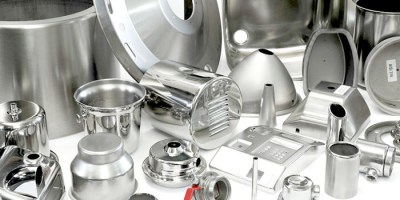Remarks: Aluminum references also include their alloys.
In the global economy, aluminum and its alloys are vital. The use of aluminum is second only to iron and steel worldwide. The latest data shows that there are more than 33 million tons of world primary aluminum production. The main producers are China, Russia, the United States and Canada.
A snapshot of 1950 to 2006 world aluminum production shows its exponential rate of growth.
Production figures are: 1950–1.5 1970 –9.0 1990–19.3 2000–24.3 2006–33.7
These figures reflect the growing role of aluminum in the world. Growth is expected to continue as alumina, the raw material used for aluminum production, is abundant and globally available. Furthermore, environmental concerns and the requirements for fuel efficiency are likely to keep aluminum at the forefront.

1. Why aluminum’s metallurgical properties important for metalworking- stamping aluminum or forging Alu?
The distinctive metallurgical characteristics of aluminum make it appropriate for various applications.
Corrosion Resistance. Aluminum has very high resistance to corrosion primarily due to a thin oxide protective layer created almost instantly when the metal is subjected to air or any oxidizing medium.
Light (low density) weight. The specific gravity of aluminum is 2.7 versus 7.8 for steel and 8.8 for copper. The metal can attain elevated strengths by alloying or working cold. The combination of low density and high strength provides a distinctive, high strength-to-weight ratio for aluminum.
Thermal and electrical behaviour. Due to its elevated conductivity and low density, aluminum is an appropriate substitute for copper in heat and electrical applications. By weight, its electrical conductivity is almost twice that of copper, yet aluminum is priced at about half that of copper at the moment.
Aluminum is a extremely radiant energy reflection. It is non-magnetic and is therefore appropriate for the electronic and electrical industries.
2. Why vehicle production used more aluminum material?
Over the past decade, aluminum use in the automotive industry has nearly increased. It is the superior resistance to corrosion and low density of aluminum which makes it extremely appropriate for the automotive and aircraft industries. In the automotive industry, a push for lightweight vehicles and trucks has been spurred by both economic and environmental issues. Every pound of aluminum replacing two pounds of steel in a car saves 20 pounds of carbon dioxide over the lifetime of the car, according to the International Aluminum Institute (IAI).

Replacing aluminum alloy steel parts significantly decreases the weight of a car without decreasing its size. With every 10% reduction in car weight, fuel consumption is reduced by 6% to 8%. Aluminum-based alloys such as aluminum-magnesium-silicon (AlMgSi) 6000 series are gradually being substituted by iron-based autobody panels.
It is useful for the atmosphere because aluminum is extremely recyclable and generating it from scrap requires less energy than from raw materials.
3. What are the aluminum alloy and temper designation systems for different manufacturing components?
Designation for alloy. The Association of Aluminum utilizes a conventional number system of four digits. The table below demonstrates the primary alloy components used in each (only for products made of aluminum).
1series: Aluminum (Al) 99.0 percent minimum, no alloying element
2series: Copper (Cu)
3series: Manganese (Mn)
4series: Silicon (Si)
5series: Magnesium (Mg)
6series: Mg and Si
7series: Zinc (Zn)
8series: Other elements
9series: Unused series
Temper Designation. The temper designation system indicates the cold- working and heat-treating histories:
F As fabricated
O Annealed
H Strain hardened (wrought product only)
W Solution heat-treated
T Heat-treated to produce stable tempers other than F, O, or H
4. What factors we should consider use aluminum part instead of existing steel part?
The mechanical and physical characteristics of carbon steel and aluminum vary, and the following general precautions are necessary for stamping operations.
- Approximately 65% of carbon steel is capable of deep drawing and biaxial stretching of aluminum. Therefore, part design must limit two-thirds of what would be allowed to form steel to an area.
- The tool bend radii should be approximately three times that of steel for similar requirements for formability.
- The sensitivity of the strain is low for aluminum, which produces high stress during the initial drawing phase, and the fracture of the part may occur. To compensate for this, it is necessary to lower the hold-down pressure and increase the radii for the draw-ring and the punch nose.
- Aluminum is stronger than carbon steel, so any blanking tool should be designed with close tolerances and should be sharp. In subsequent bending operations, burrs need to be minimized to reduce edge splitting.
- Spring back is higher for aluminum because of its lower elastic module. Compared with steel parts, the machines must be designed to compensate for the increased spring back.
-
5. How to prevent stamping aluminum parts galling?
The friction between the sheet and the instruments causes galling. Any friction reduction action will assist to decrease galling.
Aluminum forms an oxide on the surface immediately after exposure to air, which is quite abrasive to punches, so adequate lubrication is essential. To decrease or eliminate the abrasive action, the lubricant should be stable enough so that a very thin layer is always present between the punch and the portion drawn.
The manufacturer is currently covering many punches. These coatings have a significant reduction in friction and galling.
Also critical is the layout of the punches and dies. Because aluminum has low yield and tensile strengths, if the radii are not adjusted correctly, grains can be torn off the surface of the tool easily. The alloy’s grain size should be tiny. Large microstructural grains tend to break readily from the surface and stick to the punch, causing galling. The surface of the sheet must also be as smooth as possible. It is essential that the surface is sufficiently porous to maintain lubrication but smooth enough to minimize friction.
- Do T tempers age-harden over time?
Yes. Most T temperatures of the age-hard sequence that can genuinely age-or precipitate-hard over time. How long and how much depends on which alloy components in the aluminum alloy are present to harden. Age-hardening is a method of time-hardening of the alloy, improving durability along with yield and tensile strengths.
The metallurgical concept behind this phenomenon is slight oversaturation, with the alloy component at a greater temperature than the solution, followed by rapid cooling in order to maintain the metals in the solution. As time goes on, the super-saturated components tend to precipitate (or simply distort the lattice), and some eventually create a very good microstructure. Durability improves slowly during this rainfall phase, depending on the quantity. For example, in a few days, 2series: alloys achieve complete hardening, but the 6series: and 7series: alloys can take years to naturally complete hardening.

